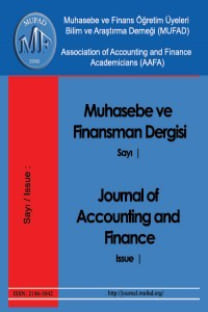Genişletilebilir İşletme Raporlama Dili'nin (XBRL) Finansal Raporlama Gelişimine Katkısı ve TMS Taksonomisi Uygulaması
Finansal raporların Word, PDF, Excel, HTML gibi farklı elektronik formatlarla kayıt altına alınması finansal tablo kullanıcılarınınişini zorlaştırmaktadır. Bu sebeple finansal raporlamada standart bir dilin geliştirilmesi amacıyla Genişletilebilir İşletme Raporlama Dili(XBRL) oluşturulmuştur. XBRL ile taksonomiler oluşturularak finansal veriler etiketlenmekte ve böylelikle finansal verilerinkarşılaştırılması, tekrar kullanımı, paylaşımı ve analizi kolaylaşmaktadır. Birçok ülkede finansal raporlama taksonomilerinin oluşturulmasıve geliştirilmesi için adımlar atılmıştır. Ülkemizde de Kamu Gözetimi Muhasebe ve Denetim Standartları Kurumu tarafından yapılandüzenleme ile birlikte Borsa İstanbul’da işlem gören işletmeler, 2016 yılının üçüncü çeyreğinden itibaren finansal tablolarını TMSTaksonomisi’ne uygun olarak Kamuyu Aydınlatma Platformu’na yüklemeye başlamışlardır. Bu çalışmanın amacı, Türkiye’de muhasebestandartlarına göre raporlama yapan işletmelerin 2016 TMS Taksonomisi hakkındaki görüşlerini tespit etmektir. Bu amaçla yirmi dörtsorudan oluşan bir anket formu oluşturulmuş ve bu form Borsa Istanbul’da işlem gören 526 işletmenin muhasebe departmanındaçalışanlarına e-mail yoluyla ulaştırılmıştır. Anketin güvenilirliği Cronbach katsayısı ile test edilmiş, güvenilirlik katsayısı 0,922 olaraksaptanmıştır. Araştırmaya katılanların çoğunluğu XBRL uygulamasının gerekli olduğunu ifade ederken, yaklaşık yarısı 2016 TMSTaksonomilerinin veri girişi için yeterliliği konusunda kararsızdır
Contribution to Financial Reporting Development of Extensible Business Reporting Language (XBRL) and TAS Taxonomy Practice
The recording of financial reports in different electronic formats such as Word, PDF, Excel and HTML makes the financial statement users job harder. For this reason, the Extensible Business Reporting Language (XBRL) was formed to develop a standard language in financial reporting. Taxonomies are created by using XBRL and financial data are labeled, thus facilitating the comparison, reuse, sharing and analysis of financial data. In many countries steps have been taken to form and develop financial reporting taxonomies. Companies that are traded in the Borsa Istanbul with the regulation formed by the Public Oversight Accounting and Auditing Standards Institution in our country have started to upload their financial statements to the Public Disclosure Platform in accordance with TAS Taxonomy from the third quarter of 2016. The aim of this study is to determine the opinions of the companies reporting in accordance with accounting standards in Turkey on the 2016 TAS Taxonomy. For this purpose, a questionnaire which consisting of twenty-four questions was created and this form was sent to the employees of the accounting department of 526 companies traded in Borsa Istanbul by e-mail. The reliability of the questionnaire was tested with the Cronbach coefficient and the reliability coefficient was found to be 0.922. While the majority of research participants state that XBRL implementation is necessary, approximately half of those are undecided about the adequacy of 2016 TAS Taxonomy for data entry.
___
- Bonson, Enrique - Cortijo, Virginia - Escobar, Tomas (2009), “Towards the global adoption of XBRL using International Financial Reporting Standards (IFRS)”, International Journal of Accounting Information Systems, 10(1), pp. 46-60.
- Doğan, Mustafa (2013), “Genişletilebilir işletme raporlama dili (XBRL): eleştirel bir bakış”, Muhasebe Bilim Dünyası Dergisi, 15(2), ss. 145-161.
- Erkuş, Hakan (2008), XBRL Genişletilebilir işletme raporlama dili, Gazi Kitabevi, Ankara.
- IASB (2014), IFRS taxonomy guides: Guide to understanding the IFRS taxonomy update. http://www.ifrs.org/-/media/feature/standards/taxonomy/generalresources/understanding-ifrs-taxonomy-update.pdf
- Ramin, Kurt - Reiman, Cornelis (2013), IFRS and XBRL: How to improve business reporting through Technology and objective tracking, Wiley Publication.
- Valentinetti, Diego - Rea, Michele A. (2012), “IFRS Taxonomy and financial reporting practices: The case of Italian listed companies”, International Journal of Accounting Information Systems, 13(2), pp. 163-180.
- Valentinetti Diego - Rea, Michele A. (2013), “XBRL for financial reporting: Evidence on Italian GAAP versus IFRS”, Accounting Perspectives, 12(3), pp. 237-259.
- Yıldırım, Meriç - Sağlar, Jale (2014), “Finansal tabloların sunumunda XBRL kullanımı: ABD örneği ve Türkiye’de uygulanabilirliği”, Anadolu Üniversitesi Sosyal Bilimler Dergisi, 14(4), ss. 69-82.
- www.iasplus.com/en/resources/ifrsf/advisory/itcg
- www.ifrs.org/XBRL/IFRS-Taxonomy/Pages/Previous-taxonomies.aspx
- www.ifrs.org/xbrl/pages/The-IFRS-Taxonomy-Consultative-Group-.aspx
- www.ifrs.org/xbrl/pages/xbrl.aspx
- www.kap.gov.tr
- www.kgk.gov.tr/contents/files/TMSTaksonomosi/TaksonomiDuyuruMetni.pdf
- ISSN: 2146-3042
- Yayın Aralığı: Yılda 4 Sayı
- Başlangıç: 2005
- Yayıncı: Muhasebe ve Finansman Öğretim Üyeleri Derneği (MUFAD)
